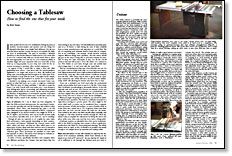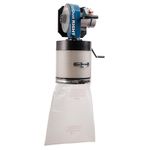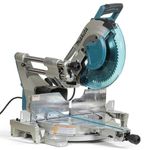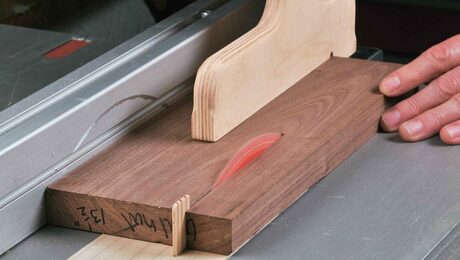Choosing a Tablesaw
How to find the one that fits your needs
Synopsis: Rich Preiss has learned a lot about tablesaws and advises that there is no single “best” tablesaw. The goal in choosing one is to first decide what you really need for your work. The solution isn’t in the machine, it’s in you. In this article, he breaks tablesaws down into four categories: the fully enclosed stationary saw, the open-based contractor’s saw, the specialty saw, and the benchtop saw. He explains their basic operation, blade sizes and arbors, horsepower, rip fence capacity, miter gauges, construction materials, and unique saws. Separate mini-articles on each of the four types of saws explain them in detail, and he charts the features and distinctions of 22 saws.
I have pushed wood over a lot of tablesaws during my years as student, furnituremaker and teacher, and one thing I’ve learned is that there is no single “best” tablesaw. Nor do you need the finest machine money can buy to accomplish the highest level of workmanship. The goal in choosing a tablesaw should be to first decide what you really need for your work (this is not to be confused with what you merely want) then to select the most appropriate tool and use it to your maximum ability. A machine larger and more expensive than you need will, at best, wind up as inappropriate in your shop and could rob the resources necessary to purchase other needed equipment.
In support of this, I would like to relate a short tale. After graduating from school, I was faced with the furnituremakers’ nightmare—I no longer had access to a shop. My landlord was doing some remodeling and had brought in an older-style 10-in. Sears tablesaw to help with the work. I was taken by the simple, rugged design that had enabled it to survive for so many years.
I decided to try making a run of small, decorative boxes completely on what had been, up to now, a rough-use contractors’ saw. With the help of a sharp sawblade, 1 was able to resaw the boxes’ 5-in.-wide boards with over/under cuts. I next devised a mini sliding-table jig for crosscutting, and ultimately machined delicate splined miters for the corners. By the end of the project my illusions of dependency on ever-fancier machine tools were shattered. True, if I’d had a better saw I would have used it, but the final solution wasn’t in the machine, it was in me.
Types of tablesaws—As I see it, there are four categories of saws: the fully-enclosed stationary saw, the open-based contractors’ saw, the specialty saw, and the benchtop saw, which is often “motorized” (direct drive) and frequently has only a -in.-dia. arbor. Stationary saws weigh-in at upwards of 300 lb., contractors’ saws (designed to be moved around a lot) might be 50 lb. to 100 lb. lighter, and benchtop saws can be hauled around easily by one person. Specialty saws, as we shall see, can be anything.
Though all saws are expected to do roughly the same tasks, their performance varies greatly depending on their construction, power, and features. Tablesaws rip, crosscut, resaw, mold, miter, rabbet and dado, and they are often called upon to cut many types of joints. Many saws have add-ons such as extension tables for handling full plywood sheets, extension rails and dustcollection gear, These accessories are standard on some saws and optional on others. This article won’t attempt to evaluate accessories, but rather the basic tablesaw.
From Fine Woodworking #56
For the full article, download the PDF below:
Fine Woodworking Recommended Products

Rockler Dust Right 650 CFM

Makita LS1219L Miter Saw

Starrett 12-in. combination square





















Log in or create an account to post a comment.
Sign up Log in